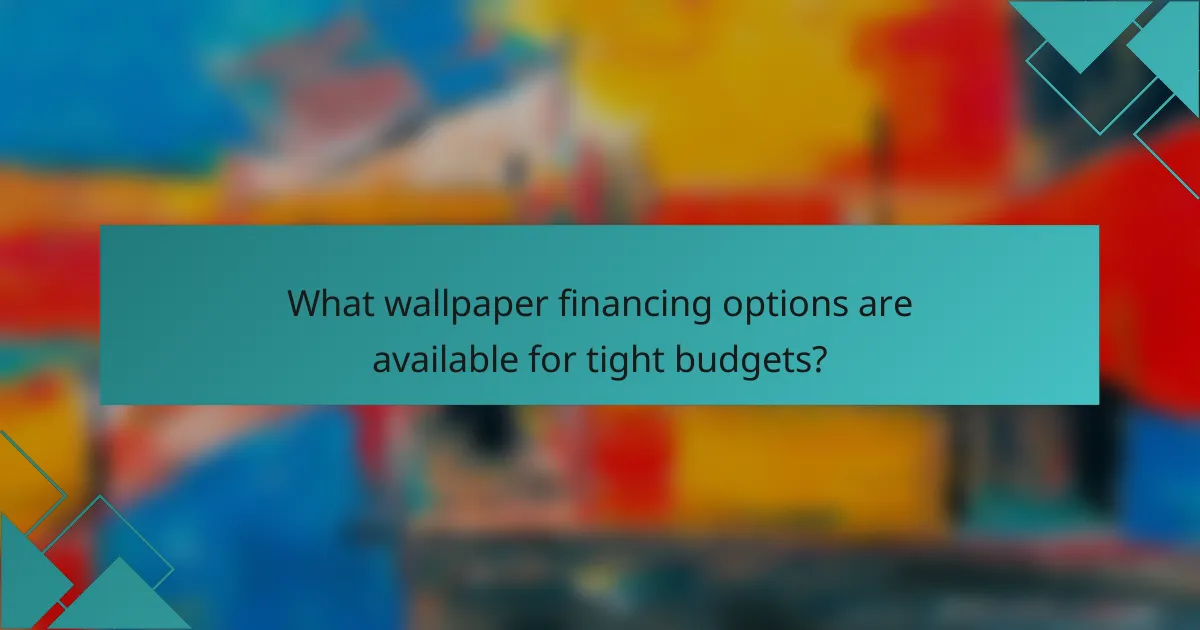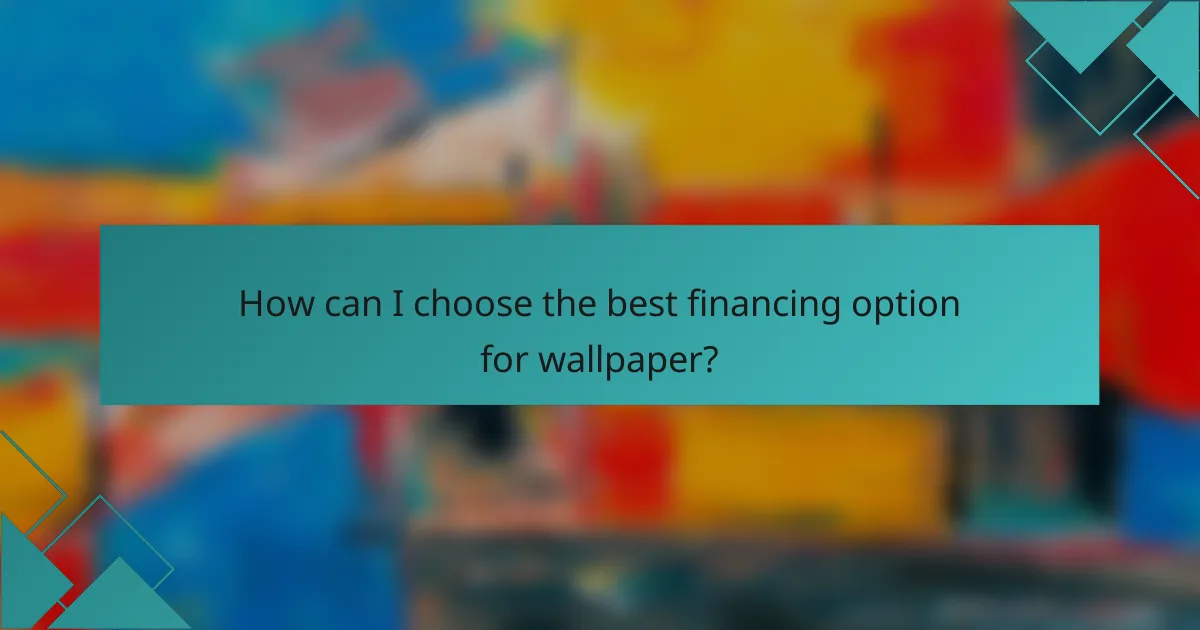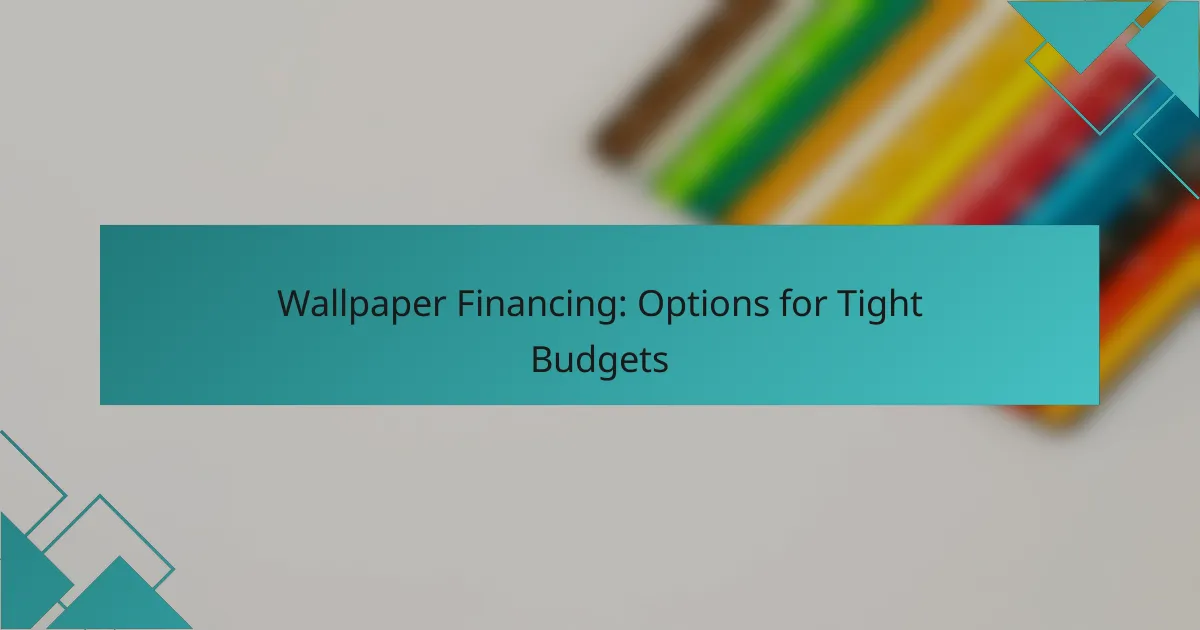For those on tight budgets, financing options for wallpaper can make stylish home decor more accessible. Options like credit card financing, personal loans, and buy now, pay later services allow homeowners to spread out costs while considering factors such as interest rates and repayment terms. By exploring these choices, you can enhance your living space without the burden of immediate full payment.

What wallpaper financing options are available for tight budgets?
For those on tight budgets, several financing options can help manage the cost of wallpaper. These include credit card financing, personal loans, store financing plans, and buy now, pay later services, each with its own advantages and considerations.
Credit card financing
Credit card financing allows you to purchase wallpaper and pay for it over time. Many credit cards offer promotional periods with low or zero interest rates, which can be beneficial if you can pay off the balance before the promotional period ends.
However, be cautious of high-interest rates after the promotional period. It’s advisable to compare different cards and choose one with favorable terms, ideally one that offers rewards or cashback for home improvement purchases.
Personal loans
Personal loans are another option for financing wallpaper, typically offering fixed interest rates and set repayment terms. These loans can provide a lump sum that you can use to cover the entire cost upfront.
When considering a personal loan, check your credit score to secure the best rates. Loan amounts can vary widely, often ranging from a few hundred to several thousand dollars, so ensure you only borrow what you need.
Store financing plans
Many home improvement stores offer financing plans specifically for wallpaper purchases. These plans may include deferred interest or installment payment options, allowing you to spread the cost over several months.
Always read the fine print, as some plans may have high-interest rates if the balance is not paid off within the promotional period. Look for stores that offer flexible payment terms and no hidden fees.
Buy now, pay later services
Buy now, pay later (BNPL) services enable you to purchase wallpaper immediately and pay for it in installments. These services often do not require a credit check and can be a quick way to finance your purchase.
While BNPL can be convenient, be mindful of the payment schedule and any potential late fees. It’s essential to ensure you can meet the payment deadlines to avoid additional costs.

How can I choose the best financing option for wallpaper?
To choose the best financing option for wallpaper, consider factors like interest rates, repayment terms, and the total cost of financing. These elements will help you determine which option fits your budget and financial goals.
Assess interest rates
Interest rates significantly impact the overall cost of financing wallpaper. Look for options with lower rates, as even a small difference can lead to substantial savings over time. Rates can vary widely, typically ranging from low single digits to high double digits, depending on your creditworthiness and the lender.
Compare offers from multiple lenders to find the most competitive rates. Be cautious of promotional rates that may increase after an introductory period, as this can affect your long-term budget.
Evaluate repayment terms
Repayment terms dictate how long you have to pay off the financing and the frequency of payments. Shorter terms may result in higher monthly payments but lower overall interest costs, while longer terms can ease monthly budgets but increase total interest paid.
Common repayment periods for wallpaper financing can range from a few months to several years. Ensure you select a term that aligns with your financial situation and comfort level with monthly payments.
Consider total cost of financing
The total cost of financing includes not only the principal amount borrowed but also the interest and any additional fees. Calculate the total cost to understand how much you will ultimately pay for your wallpaper.
When comparing financing options, create a simple table or list that outlines the principal, interest, fees, and total repayment amount for each option. This will help you make an informed decision and avoid unexpected costs down the line.

What are the benefits of financing wallpaper?
Financing wallpaper allows homeowners to access stylish options without immediate full payment, making it easier to enhance their living spaces. This approach can help manage expenses while still achieving desired aesthetics.
Immediate access to products
Financing provides the advantage of immediate access to wallpaper products that may otherwise be unaffordable upfront. Homeowners can select high-quality designs and styles without waiting to save the total amount.
This option is particularly beneficial for those looking to complete home renovations or updates quickly, as it enables them to start projects without delay. Many retailers offer financing plans that can be approved on the spot, allowing for instant purchases.
Flexible payment options
With wallpaper financing, consumers can choose from various payment plans that suit their financial situations. Options may include monthly installments, deferred payments, or low-interest financing, making it easier to budget.
For example, a homeowner might opt for a 12-month payment plan that spreads the cost over time, allowing for manageable monthly payments. It’s crucial to compare interest rates and terms to find the most favorable deal.
Ability to manage cash flow
Financing wallpaper helps homeowners manage their cash flow effectively by allowing them to allocate funds to other essential expenses while still improving their living spaces. This is especially useful for those on tight budgets.
By spreading the cost over several months, individuals can avoid large, one-time expenditures that could disrupt their financial stability. However, it is important to ensure that monthly payments fit comfortably within the overall budget to prevent financial strain.

What are the risks associated with wallpaper financing?
Wallpaper financing can lead to several financial risks that borrowers should be aware of. These include high-interest rates, the potential for accumulating debt, and negative impacts on credit scores.
High-interest rates
Many wallpaper financing options come with high-interest rates, which can significantly increase the total cost of the purchase. Rates can vary widely, often ranging from the low teens to over 30% APR, depending on the lender and the borrower’s credit profile.
Before committing, it’s crucial to compare different financing offers. Look for options with lower interest rates or promotional periods with no interest to minimize costs.
Potential for debt accumulation
Wallpaper financing can easily lead to debt accumulation if not managed carefully. Borrowers may find themselves making minimum payments while the balance remains high, resulting in a cycle of debt that can be hard to escape.
To avoid this pitfall, set a budget for your wallpaper project and stick to it. Consider paying more than the minimum payment when possible to reduce the principal balance faster.
Impact on credit score
Taking on wallpaper financing can affect your credit score, especially if payments are missed or late. High credit utilization from taking on new debt can lower your score, making future borrowing more expensive.
To protect your credit score, ensure timely payments and keep your overall debt levels manageable. Regularly check your credit report for any discrepancies and address them promptly.

What should I know about financing wallpaper in the UK?
Financing wallpaper in the UK involves understanding your options for spreading the cost over time, especially if you’re on a tight budget. Various lenders offer financing solutions, but it’s essential to consider interest rates, regulatory protections, and the overall affordability of repayments.
Regulatory protections
In the UK, financing agreements are regulated by the Financial Conduct Authority (FCA), which ensures that lenders adhere to fair practices. This includes providing clear information about terms and conditions, as well as ensuring that borrowers can afford repayments without undue hardship.
Consumers are protected under the Consumer Credit Act, which gives you the right to cancel a credit agreement within 14 days and provides a cooling-off period. Additionally, if you encounter issues with the wallpaper or the service, you may have the right to claim against the lender under the “section 75” rule for purchases over a certain amount.
Popular lenders
Several lenders in the UK specialize in home improvement financing, including wallpaper purchases. High street banks, credit unions, and online lenders like Klarna and PayPal Credit are commonly used options. Each lender may offer different terms, so it’s wise to compare their rates and repayment plans.
Some retailers also provide in-house financing options, allowing you to pay for wallpaper directly through them. This can simplify the process, but always check the interest rates and terms to ensure they are competitive.
Average interest rates
Interest rates for wallpaper financing in the UK can vary widely, typically ranging from around 5% to 30%, depending on your credit score and the lender. Generally, those with better credit ratings will secure lower rates, while those with poor credit may face higher costs.
It’s advisable to shop around and consider the total cost of financing, including any fees, to find the best deal. Look for promotional offers that may provide interest-free periods, which can significantly reduce the overall expense of your wallpaper financing.
